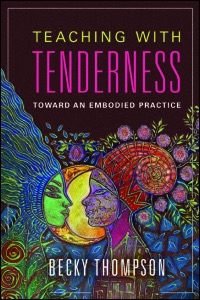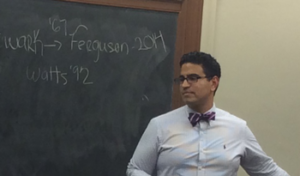embodied teaching
Select an item by clicking its checkbox
As I geared up to teach two social justice themed courses this Fall, my summer preparations were disrupted by the news of two tragedies and the reflections they prompted. First was the death of Omar Abrego, beaten to death by police on August 2 in Los Angeles. Witness reports claim that ...
“I’m just so sick of feeling awkward,” I told my spouse the night before the first day of classes this semester. After having taught for eight years in another school across the country, I was about to begin teaching at a new institution. I was bemoaning the fact that ...

Teaching with Tenderness - Toward an Embodied Practice
Date Reviewed: January 25, 2018
Antagonisms, conflicts, and oppositions characterize societal relations. Becky Thompson acknowledges these realities throughout her book with careful attention and still makes the case for a post-oppositional approach. This is the book’s greatest strength, offering hope and healing through tenderness while walking through the ruin and devastation brought about by dominating power and systems of inequality.
Thompson asks, “What rituals might we incorporate into teaching that invite the body into the classroom? What is it about the structure of academe that leads us to flee our bodies? How can we find them again? What risks will this take? What truths do we need to tell about our lives and our teaching that we have been hiding from ourselves, or barely whispering? How might inviting bodies into the classroom change how we seek justice in the world?” (13). Thompson responds to each of these questions by leading readers through an interdisciplinary and innovative collection of figures and concepts without sacrificing the book’s rigor.
Given the hardening of boundaries and identities in discussions about power and privilege, Thompson’s work brings a refreshing proposal and argument for countering defensiveness and getting to “a soft place with each other” (36). For teachers of all stripes, this means overcoming a dichotomy between mind and body often inherited and passed along in the academe (64). Making a case for “embodied pedagogy” (39), Thompson lifts up the very essential need to facilitate a “resocialization process” (88) whereby students are enabled to feel connected with each other and themselves.
Teaching with Tenderness is exceptional because it does not offer easy solutions. For instance, Thompson notes the difficulty of inviting in people’s personal stories “without encouraging an atmosphere where students feel they must share in order to succeed” (72). For teachers untrained in professional therapeutic strategies, overcoming the desire to “outsource the emotional content of our courses” (89) takes soul work and the willingness to deal with the messiness of what Thompson memorably refers to as “the warp and woof” of that which makes us all human (90).
The book also offers an implicit challenge to teachers, scholars, and researchers for whom gathering data, research, and analysis is part of their bread and butter. While recognizing these as necessary, Thompson notes that academics need to conduct research “with” and not “on” the communities they are describing or analyzing (108).
Thompson’s work speaks to those interested in carving out a new path in teaching and learning where there is neither exclusion nor appropriation, neither denial nor naiveté, neither easy solutions nor pages filled with jargon. This book is a must-read for anyone interested in the challenge and promise of interdisciplinary work that takes the whole person into account as part of envisioning a pedagogy where all things are done as if everyone mattered – body, mind, and all.
My teaching goals reflect my expectations that my students will change the world. I want my students to have profound consciousness of love, of themselves as capable beings, of the beauty of creation. I want to instill in them with the necessity to fight for the oppressed, uplift the downtrodden, ...

Indigenous Leadership in Higher Education
Date Reviewed: November 30, -0001
Excellence is seldom achieved alone. These words express one of the major themes of Indigenous Leadership in Higher Education, edited by Robin Starr Minthorn and Alicia Fedelina Chávez. Consisting of autobiographical narratives, the editors and contributors weave a blanket of experiences and guiding principles which illustrate and encourage the involvement of Indigenous leaders throughout the academy. Many of the narratives begin in the traditional manner with the authors situating themselves within their maternal and paternal lines, recognizing the interconnectedness of the present to the past in order to lead future generations well. That sense of community permeates the various narratives, weaving a thread into the blanket of colors that blends the experiences and insights into what constitutes Indigenous leadership.
This blend of narratives is most evident in the second and the final chapters, in which the editors succinctly gather individual contributors’ words and correlate them to particular themes that serve as a wheel of knowledge in chapter two and summarize potential methods for incorporation into higher education in the final chapter. In chapter two, “Collected Insights,” the editors provide a wheel of four major components of what constitutes Indigenous leadership. The last chapter highlights approaches and philosophies, strategies, academics, and means of working with students to promote and encourage leadership for Indigenous peoples. While it may be tempting to read just these two chapters because of the breadth contained therein, the narratives themselves expand on one or more of the dimensions discussed in these two chapters.
One of the major themes is that Indigenous leadership is communal rather than a solo endeavor; Bryan McKinley Jones Brayboy writes that “Indigenous leadership requires individuals to see themselves as part of a unified whole” (53). In chapter two, the editors provide other examples that demonstrate the importance of connection to the community through its elders and the people for whom one serves.
Even though most of the narratives are directed toward Indigenous leadership in higher education, many of the principles can be applied to all persons in the academy. The narratives help educators rethink how to provide opportunities for all students to grow in wholeness and wisdom, not just knowledge of facts.
Among the qualities the editors describe as “what we strive to embody,” (17) qualities that may resonate with all Indigenous persons, for me, one is clearly lacking. As a Native Hawaiian, I would include gratefulness. While this quality may be imbedded in the concepts of generosity, humility with confidence, and spirituality, I found few expressions of gratitude within the narratives. This disconcerted me because it is inconsistent with what I learned from my kupuna, my Elders. I would hope that, while this embodiment is not expressly evident in the narratives, it is part of their respect for the Elders who have wrapped them in the blankets of experience and provided them with the warmth that enabled them to be Indigenous leaders.


